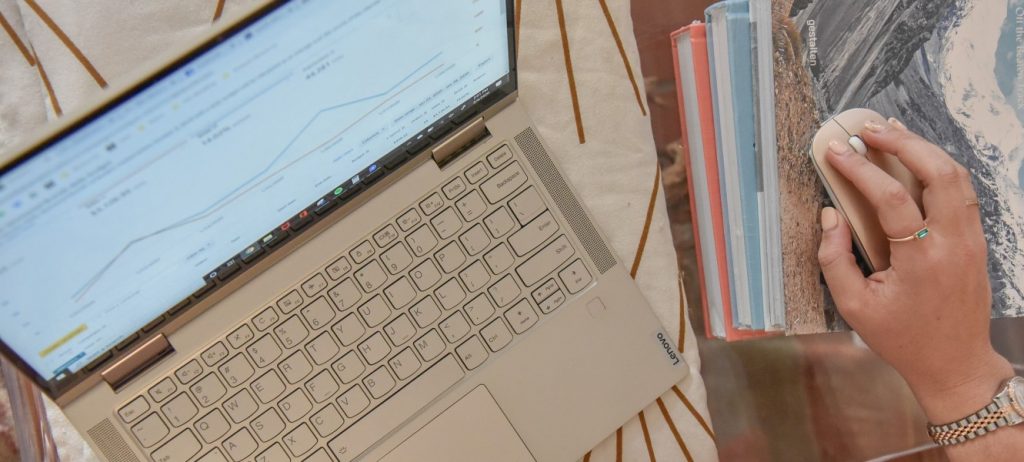Alumni Spotlight
Tips to Transitioning to Remote Work in the Wake of COVID-19

Working from home is the new normal for many of us. Gabi Viljoen `17MBA is a digital nomad who shares her tips for remote work.
Guest author: Gabi Viljoen `17MBA, eCommerce Brand Manager and Consultant
There’s a new norm facing many of us in the wake of the global coronavirus pandemic. By this point, the effects of the virus are widespread and virtually inescapable (pun unintended). Many economies, industries, and communities are facing a new reality that can be and has been devastating, and many more are doing their part to #flattenthecurve by shifting to a work from home model, where possible. Search terms in the work from home tips and advice category have seen a considerable spike in recent weeks, even days.
That being said, whilst I have been quite comfortable in a digital nomad life for a while now, I find myself answering questions by friends and colleagues, on how to manage this shift of working and studying as productively as possible in self-isolation. I made the shift nearly two years ago from a full-time in-office environment to a fully remote lifestyle with thousands of miles and a 5-7-hour time difference. I quite literally threw myself in the deep end and made it work. Plus, when you’re surrounded with a network of remote workers and digital nomads who are inspirational and disruptive in their own industries, you pick up a couple of tips, and fast.
I still come across a conversation of prejudice, that working remotely inherently means working less, or of lesser quality, but in my experience and the experiences of the remote professionals in my network, that couldn’t be farther from the truth. There’s quite simply a fear of stepping outside the routine, where many schedules and choices are made for you in a traditional in-office work environment.
I’ve put together a couple of tips that really helped me in my transition and as I began to perfect my new routine, that I hope can help some you. This list is not structured in any priority, we are individuals at the end of the day, and therefore what’s my ‘must-have’ advice may already be one of your strengths! So, here we go:
Have your schedule, and stick to it
If you’re transitioning from an in-office environment to working from home, you’ve already got a routine and schedule that you live by. It can be tempting to roll out of bed at 7:45 a.m. with your robe on and coffee in hand to log on your laptop by 8:00 a.m., but please don’t do this! Your morning routine of waking up well in advance of ‘work time’ is critical to giving your brain and body the heads up needed to be productive. Get up, get dressed, and get mentally ready.
Find your optimal productivity times
 This was the biggest game-changer for me, as with everything I do I’m aiming for increased productivity and efficiency. This is a great opportunity for you to thrive by working during your most productive hours of the morning, day, or night. Personally, I find myself to be most productive first thing in the morning, and then again after that midday slump – so I’ll set an early alarm to take advantage of the quiet before everyone else gets going and dedicate a work block where I can zone in without being bothered.
This was the biggest game-changer for me, as with everything I do I’m aiming for increased productivity and efficiency. This is a great opportunity for you to thrive by working during your most productive hours of the morning, day, or night. Personally, I find myself to be most productive first thing in the morning, and then again after that midday slump – so I’ll set an early alarm to take advantage of the quiet before everyone else gets going and dedicate a work block where I can zone in without being bothered.
After several hours I may notice my attention waning and I do my best to avoid not being fully invested in the task at hand. I’ll step away to workout, take the dog for a run, or do chores. Anything that gives my mind that time to reset and ready to kick back into gear for the next block of work. Being distracted or partially-invested invites error and reduced memory function. Find a work block that works for you, but be cognizant of being available to colleagues who may need your time for collaboration.

Create a dedicated workspace
I don’t know about you, but I feel a whole lot better, motivated, and more productive when I’ve got a neat environment. First thing’s first, find a space in your home that you can set up and keep as a dedicated area that’s your own little office. If you’ve got a study, spare room, or desk – that’s great, this will be easier for you. If not, set up on the dining table or somewhere where you can sit (or stand!) for several hours at a time comfortably. Keep this clean, organized, and as free from distraction as possible. If you’re into it, light up a candle with some jasmine, rosemary, peppermint or similar – all of these efforts are to help your brain lock-in to the task at hand and associate this area and time with focused work.
Separate work from home, when you’re working from home
This is a two-part tip from a physical and time perspective, and probably the overall theme of being successful in a remote or home working environment IMO. No pajama uniforms and laptops-from-bed here, please! Physically, that dedicated workspace tip above is important. From a time perspective, it’s important to keep to your productive blocks of work as much as possible. Try not to be tempted to be ‘online’ throughout your hours at home.
When you work, you work
To keep yourself sane, free from mental exhaustion and burnout, stick to that productive schedule. When it’s time to work, keep that as your focus, don’t try to juggle housework or other distractions whilst working. Rather keep your blocks of work shorter but fully productive, than finding yourself partially attentive for several hours. I like to keep my laptop on ‘priority only’ notifications and phone on ‘do not disturb’ to help.
But give yourself your me-time
It’s okay, critical even, to break up work blocks with something to give your mind a break and keep things moving. Grant yourself sufficient time blocks to exercise, get fresh air, do those house errands, whatever it may be. If after my ‘work day’ I see emails or a work-related task that can’t wait until the next morning, I make sure to finish what I’m doing in that personal or family capacity first and then sit down to be fully invested in responding to that work issue – rather than being half involved in both activities at the same time. No one’s going to appreciate that.
Avoiding cabin fever
I find this one really important when I’m working remotely (outside of a world surrounded by COVID-19), but I recognize it’s harder to do under quarantine, social distancing, and self-isolation circumstances. Working from cafés and similar spaces is a great environmental stimulant, but is likely out of the question in many parts of the world at this point. To combat that, I keep working from home in my dedicated desk space, but incorporating more breaks if I get distracted, planning a bike ride or dog walk outside in the day if I can, or changing up my dedicated space by reorganizing and rearranging plants, even moving to my ‘standing desk’ at the bar top counter for a couple of hours.
Communication and Collaboration
All of the above are tips on how to build yourself a work sanctuary and unlocking your most productive self when distractions and a lack of routine can be rife. This last tip here is a collection more so on how to make the most of connecting with the rest of your colleagues when everyone’s in it together. You’ll probably find here that many of those meetings, actually could have been emails! 😉
Get in that face time
You’ve had the majority of your human interaction withdrawn, but that doesn’t mean you can’t still connect. Phone and voice calls are good for many things, but a video call on Slack, Zoom, Skype, Facetime (you get the point) is far greater to keep the connection and collaboration going.
Live documents and project management tools
Where multiple people are brainstorming or working on projects together, who may be used to popping over to the nearby desk and chatting about updates, using cloud-based ‘live’ documents and project management tools keeps everyone in the loop about who’s done what, what’s next, and who/what needs help.
Communication
We see the importance of communication everywhere, but even the best of us will be humble enough to tell you that there’s always room for improvement. Make sure that you’re keeping team members and stakeholders informed. They’re used to seeing you working, so without that visual cue, they may otherwise we wondering what you’re up to. If it’s appropriate in your environment, schedule those quick update virtual meetings, or a regular recap email, so no one feels like they’re on the wrong track or waiting around for information.
Flexibility
In the same token, follow up where needed, but be careful not to hound your colleagues or employees for constant updates unless it truly is urgent. If you got this far, you read that the entire formula for remote success is enabling ourselves the time and space to dive in and work smart and hard without getting distracted. Rather than sending tons of emails and Slacks, send a quick “hey do you have X minutes to chat about XYZ so I can get up to date?”
There’s a difference between working from home, and efficiently working from home. We’re not here to sit around and let that clock tick over until home-time. You’ve got the opportunity to maximize a recipe to be as productive as possible in likely fewer hours – it just takes a little more self-discipline and working smarter to make this work for you.
Hopefully, some of these tips not only help you in your #WFH transition but motivate you on exactly how much can be achieved and that, now more than ever, you may find that extended remote work becomes routine.

